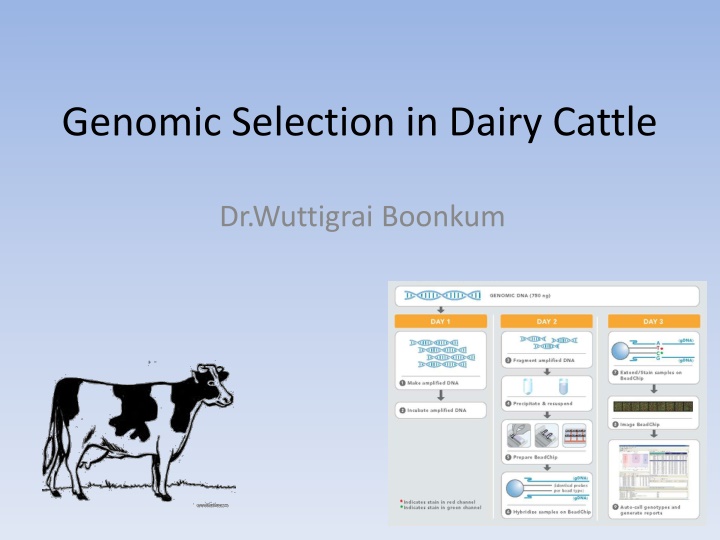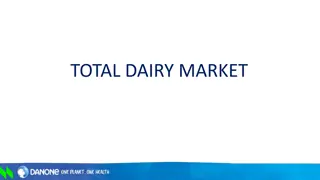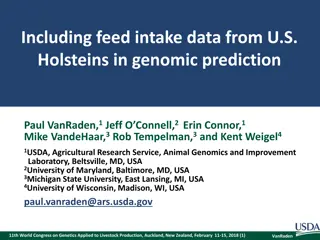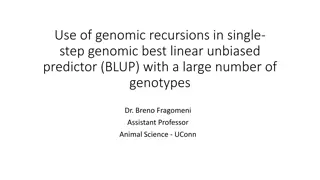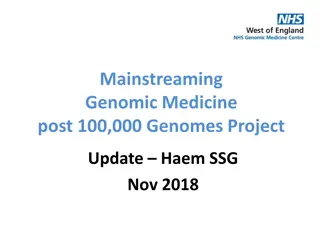Genomic Selection in Dairy Cattle: Advantages, Disadvantages, and Impact
Genomic selection in dairy cattle focuses on specialized breeds like Holstein, Jersey, Brown Swiss, and Ayrshire. It brings reliable breeding values at a young age, higher success rates in obtaining top bulls, and lower costs for test proofs, leading to a shorter generation interval. While it offers advantages such as increased genetic improvement and wider portfolios of commercial bulls, there are drawbacks, including the need for a large set of genotyped animals and high genotyping costs.
Download Presentation

Please find below an Image/Link to download the presentation.
The content on the website is provided AS IS for your information and personal use only. It may not be sold, licensed, or shared on other websites without obtaining consent from the author.If you encounter any issues during the download, it is possible that the publisher has removed the file from their server.
You are allowed to download the files provided on this website for personal or commercial use, subject to the condition that they are used lawfully. All files are the property of their respective owners.
The content on the website is provided AS IS for your information and personal use only. It may not be sold, licensed, or shared on other websites without obtaining consent from the author.
E N D
Presentation Transcript
Genomic Selection in Dairy Cattle Dr.Wuttigrai Boonkum
Genomic Selection Dairy cattle most are specialised dairy breed Holstein, Jersey, Brown Swiss, Ayrshire Some dual propose Simmental, Montbeliarde, Normande, etc More than 80% AI from AI companies Global exchange of genetic so international genetic evaluation
Genomic Selection P = G + E Genetic evaluation or Molecular genetics Appropriated major gene only Need time and data complete
Genomic Selection, What does it bring us? Reliable breeding values at young age higher success rate to get top bulls lower costs for test proofs shorter generation-interval
Reliability of breeding values Categorie Parent average GS young bull 1st EBV (prog.) 2nd EBV (prog.) 89% Production Type 35% 50-55% 80% Longevity 30% 40-45% 50-65% 50-80% 35% 45-50% 75% 81% 50% reliability is realistic
Advantages of Genomic Selection Increased genetic improvement (30-40%) Higher genetic level of test sires Higher genetic level of Delta embryo s Wider portfolio of commercial bulls & higher level More outcross; less inbreeding
Disadvantages of Genomic Selection New method, not fully proven or tested Need to genotype a sufficiently large set of animals for accurate GEBV Across breed accuracy low Genotypes still costly (10,000 bath/head)
3. Table 3Comparison of average of milk yield, reproductive performance and economic returns of Thai Friesian (TF), Thai milking zebu (TMZ) and Friebrah (FB) Dairy cattle crossbreds Traits TF TMZ FB Milk yield (kg/head/lactation) Milk yield (kg/head/day) Day in milk(day) First oestrus after calving(day) Calving interval(day) Number of service per conception(times) Income(baht/lactation) Production cost(baht/lactation) Milk production cost(baht/kg) Net profit(baht) 4,517.76+384.19 14.39+2.92 314.45+24 69.17+28 415.10+72 2.10+0.87 52,406.01 29,795.39 3,902.57+460.91 13.34+4.06 292.30+28 68.19+43 399.90+49 1.70+0.82 45,269.87 28,032.08 2,472.90+456.12 9.20+1.21 268.50+51 54.23+28 363.70+43 1.40+0.69 28,676.24 24,646.17 6.37 7.49 9.91 22,610.62 17,237.79 4,030.07 Source:( , 2549 , )
4. Heritability high medium, low BLUP BLUP Traditional Selection index by MT-BLUP G MAS Selection index by MA-BLUP G G Selection index including MA information Pre-selection by marker confirmed by MT-BLUP index G Figure 6 Dairy cattle improvement using BLUP and genetic marker scheme
